Evaluating the Spatial and Temporal Characteristics of Summer Urban Overheating through Weather Types in the Attica Region, Greece
Abstract
1. Introduction
2. Materials and Methods
2.1. Study Area
2.2. Meteorological Data
2.3. Copernicus Urban Climate Dataset
2.4. Formation of the Prevailing WTs
2.5. Urban Heat Island Intensity Calculation
3. Results and Discussion
3.1. Definition of WTs over the 41-Year Time Period (1980–2020)
3.2. Urban Heat Island Intensity Frequency Distribution
3.3. Association of WTs with Urban Overheating Magnitudes
3.4. Spatial and Temporal Characteristics of Urban Overheating during Summer
4. Conclusions
- The warm period WTs (WT2 and WT10) were reported to occur with a higher frequency between 1980 and 2020.
- As previous studies have shown, urban heat island intensities in the Attica region were exacerbated during the night, suggesting that the urban heat island is mainly a nighttime phenomenon.
- WT10 was mainly responsible for exacerbated urban overheating magnitude at daytime in all months, while urban overheating at nighttime was mostly attributed to WT2 conditions.
- WT10 is associated with the weak pressure gradient over the Aegean, causing low wind speeds mainly from northerly directions, in contrast with WT2, which is associated with stronger northerly flow.
- During the day, high urban overheating magnitudes occur mainly in sub-urban and rural areas (Mesogeia, Penteli, Aspropyrgos) of the Attica region. Conversely, urban overheating hot-spots are consistently located in urban areas, including the Athens center and central municipalities of the Athens Greater Area. In both cases, the urban overheating reached their maxima in June and September.
Supplementary Materials
Author Contributions
Funding
Institutional Review Board Statement
Informed Consent Statement
Data Availability Statement
Conflicts of Interest
References
- Mohammad Harmay, N.S.; Kim, D.; Choi, M. Urban Heat Island associated with Land Use/Land Cover and climate variations in Melbourne, Australia. Sustain. Cities Soc. 2021, 69, 102861. [Google Scholar] [CrossRef]
- Geng, X.; Zhang, D.; Li, C.; Yuan, Y.; Yu, Z.; Wang, X. Impacts of climatic zones on urban heat island: Spatiotemporal variations, trends, and drivers in China from 2001–2020. Sustain. Cities Soc. 2023, 89, 104303. [Google Scholar] [CrossRef]
- Sismanidis, P.; Keramitsoglou, I.; Kiranoudis, C.T. A satellite-based system for continuous monitoring of surface urban Heat Islands. Urban Clim. 2015, 14, 141–153. [Google Scholar] [CrossRef]
- Hayes, A.T.; Jandaghian, Z.; Lacasse, M.A.; Gaur, A.; Lu, H.; Laouadi, A.; Ge, H.; Wang, L. Nature-Based Solutions (NBSs) to Mitigate Urban Heat Island (UHI) Effects in Canadian Cities. Buildings 2022, 12, 925. [Google Scholar] [CrossRef]
- Cecilia, A.; Casasanta, G.; Petenko, I.; Conidi, A.; Argentini, S. Measuring the urban heat island of Rome through a dense weather station network and remote sensing imperviousness data. Urban Clim. 2023, 47, 101355. [Google Scholar] [CrossRef]
- Kassomenos, P.; Kissas, G.; Petrou, I.; Begou, P.; Khan, H.S.; Santamouris, M. The influence of daily weather types on the development and intensity of the urban heat island in two Mediterranean coastal metropolises. Sci. Total Environ. 2022, 819, 153071. [Google Scholar] [CrossRef]
- Liu, S.; Shi, K.; Wu, Y.; Cui, Y. Suburban greening and suburbanization changing surface urban heat island intensity in China. Build. Environ. 2023, 228, 109906. [Google Scholar] [CrossRef]
- Hoehne, C.G.; Hondula, D.M.; Chester, M.V.; Eisenman, D.P.; Middel, A.; Fraser, A.M.; Watkins, L.; Gerster, K. Heat exposure during outdoor activities in the US varies significantly by city, demography, and activity. Health Place 2018, 54, 1–10. [Google Scholar] [CrossRef]
- Oliveira, A.; Lopes, A.; Niza, S.; Soares, A. An urban energy balance-guided machine learning approach for synthetic nocturnal surface Urban Heat Island prediction: A heatwave event in Naples. Sci. Total Environ. 2022, 805, 150130. [Google Scholar] [CrossRef]
- Tang, J.; Di, L.; Xiao, J.; Lu, D.; Zhou, Y. Impacts of land use and socioeconomic patterns on urban heat Island. Int. J. Remote Sens. 2017, 38, 3445–3465. [Google Scholar] [CrossRef]
- Founda, D.; Santamouris, M. Synergies between Urban Heat Island and Heat Waves in Athens (Greece), during an extremely hot summer. Sci. Rep. 2017, 7, 10973. [Google Scholar] [CrossRef]
- Orville, R.E.; Huffines, G.; Nielsen-Gammon, J.; Zhang, R.; Ely, B.; Steiger, S.; Phillips, S.; Allen, S.; Read, W. Enhancement of cloud to-ground lighting over Houston Texas. Geophys. Res. Lett. 2001, 28, 2597–2600. [Google Scholar] [CrossRef]
- Shem, W.; Shepherd, M. On the impact of urbanization of summertime thunderstorms in Atlanta: Two numerical model case studies. Atmos. Res. 2009, 92, 172–189. [Google Scholar] [CrossRef]
- Ngarambe, J.; Oh, J.W.; Su, M.A.; Santamouris, M.; Yun, G.Y. Influences of wind speed, sky conditions, land use and land cover characteristics on the magnitude of the urban heat island in Seoul: An exploratory analysis. Sustain. Cities Soc. 2021, 71, 102953. [Google Scholar] [CrossRef]
- Giannaros, T.M.; Melas, D. Study of the urban heat island in a coastal Mediterranean City: The case study of Thessaloniki, Greece. Atmos. Res. 2012, 118, 103–120. [Google Scholar] [CrossRef]
- Wang, B.; Ding, S.; Qiao, G.; Guo, Y.; Wu, Y. Study on the Urban Heat Islands and the Meteorological Elements over the Pearl River Delta. In Proceedings of the ICUC9—9th International Conference on Urban Climate jointly with 12th Symposium on the Urban Environment, Toulouse, France, 20–24 July 2015. [Google Scholar]
- Santamouris, M.; Haddad, S.; Fiorito, F.; Osmond, P.; Ding, L.; Prasad, D.; Zhai, X.; Wang, R. Urban Heat Island and overheating characteristics in Sydney. Australia. An analysis of multiyear measurements. Sustainability 2017, 9, 712. [Google Scholar] [CrossRef]
- Reis, C.; Lopes, A.; Nouri, S.A. Assessing urban heat island effects through local weather types in Lisbon’s Metropolitan Area using big data from the Copernicus service. Urban Clim. 2022, 43, 101168. [Google Scholar] [CrossRef]
- Khan, H.S.; Santamouris, M.; Kassomenos, P.; Paolini, R.; Caccetta, P.; Petrou, I. Spatiotemporal variation in urban overheating magnitude and its association with synoptic airmasses in a coastal city. Sci. Rep. 2021, 11, 6762. [Google Scholar] [CrossRef]
- Kistler, R.; Kalnay, E.; Collins, W.; Saha, S.; White, G.; Woollen, J.; Chelliah, M.; Ebisuzaki, W.; Kanamitsu, M.; Kousky, V.; et al. The NCEP–NCAR50-year reanalysis: Monthly means CD-ROM and documentation. Bull. Am. Meteorol. Soc. 2001, 82, 247–267. [Google Scholar] [CrossRef]
- Lolis, C.J.; Kotsias, G. The use of weather types in the definition of seasons: The case of southern Balkans. Theor. Appl. Climatol. 2020, 142, 1199–1219. [Google Scholar] [CrossRef]
- Hooyberghs, H.; Berckmans, J.; Lefebre, F.; De Ridder, K. C3S_422_Lot2 SIS European Health. UrbClim Extra Documentation 1–18. 2019. Available online: https://cds.climate.copernicus.eu/cdsapp#!/dataset/sis-urban-climate-cities?tab=form (accessed on 15 July 2022).
- Borge, R.; Lumbreras, J.; Vardoulakis, S.; Kassomenos, P.; Rodriguez, E. Analysis of long–range transport influences on urban PM10 using two–stage atmospheric trajectory clusters. Atmos. Environ. 2007, 41, 4434–4450. [Google Scholar] [CrossRef]
- Mohammed, A.J.; Alarcón, M.; Pino, D. Extreme temperature events on the Iberian Peninsula: Statistical trajectory analysis and synoptic patterns. Int. J. Climatol. 2018, 38, 5305–5322. [Google Scholar] [CrossRef]
- Markou, M.T.; Kassomenos, P. Cluster analysis of five years of back trajectories arriving in Athens, Greece. Atmos. Res. 2010, 98, 438–457. [Google Scholar] [CrossRef]
- Jolliffe, I.T. Principal Component Analysis; Springer: New York, NY, USA, 1986. [Google Scholar]
- Bryant, F.B.; Yarnold, P.R. Principal-Components Analysis and Exploratory and Confirmatory Factor Analysis . In Reading and Understanding Multivariate Statistics; Grimm, L.G., Yarnold, P.R., Eds.; American Psychological Association: Washington, DC, USA, 2015; pp. 99–136. [Google Scholar]
- Bartzokas, A.; Metaxas, D.A. Factor analysis of some climatological elements in Athens, 1931–1992: Covariability and climatic change. Theor. Appl. Climatol. 1995, 52, 195–205. [Google Scholar] [CrossRef]
- Sharma, S. Applied Multivariate Techniques; John Wiley & Sons: New York, NY, USA, 1995; 512p, ISBN 978-0471310648. [Google Scholar]
- Sugar, C.A.; James, G.M. Finding the number of clusters in a dataset. J. Am. Stat. Assoc. 2003, 98, 750–763. [Google Scholar] [CrossRef]
- Alcoforado, M.J.; Lopes, A.; Alves, E.D.L.; Canario, P. Lisbon heat island statistical study (2004–2012). Finisterra 2014, 49, 61–80. [Google Scholar] [CrossRef]
- Oke, T.R.; Mills, G.; Christen, A.; Voogt, J.A. Urban Climates; Cambridge University Press: Cambridge, UK, 2017. [Google Scholar] [CrossRef]
- Martin-Vide, J.; Sarricolea, P.; Moreno-García, M.C. On the definition of urban heat island intensity: The “rural” reference. Front. Earth Sci. 2015, 3, 24. [Google Scholar] [CrossRef]
- Anagnostopoulou, C.; Zanis, P.; Katragkou, E.; Tegoulias, I.; Tolika, K. Recent past and future patterns of the etesian winds based on regional scale climate model simulations. Clim. Dyn. 2014, 42, 1819–1836. [Google Scholar] [CrossRef]
- Paschalidou, A.K.; Kassomenos, P.A. What are the most fire-dangerous atmospheric circulations in the Eastern-Mediterranean? Analysis of the synoptic wildfire climatology. Sci. Total Environ. 2016, 539, 536–545. [Google Scholar] [CrossRef]
- Kassomenos, P.; Katsoulis, B. Mesoscale and macroscale aspects of the morning Urban Heat Island around Athens, Greece. Meteorol. Atmos. Phys. 2006, 94, 209–218. [Google Scholar] [CrossRef]
- Tyrlis, E.; Lelieveld, J. Climatology and dynamics of the summer etesian winds over the eastern Mediterranean. J. Atmos. Sci. 2013, 70, 3374–3396. [Google Scholar] [CrossRef]
- Houssos, E.E.; Lolis, C.J.; Bartzokas, A. Atmospheric circulation patterns associated with extreme precipitation amounts in Greece. Adv. Geosci. 2008, 17, 5–11. [Google Scholar] [CrossRef]
- Michailidou, C.; Maheras, P.; Arseni-Papadimititriou, A.; Kolyva-Machera, F.; Anagnostopoulou, C. A study of weather types at Athens and Thessaloniki and their relationship to circulation types for the cold-wet period, part I: Two-step cluster analysis. Theor. Appl. Climatol. 2009, 97, 163–177. [Google Scholar] [CrossRef]
- Maheras, P.; Anagnostopoulou, C. Circulation Types and Their Influence on the Interannual Variability and Precipitation Changes in Greece. In Mediterranean Climate—Variability and Trends; Bolle, H.J., Ed.; Springer: Berlin, Germany, 2003; pp. 215–239. [Google Scholar]
- Lolis, C.J. High-resolution precipitation over the southern Balkans. Clim. Res. 2012, 55, 167–179. [Google Scholar] [CrossRef]
- Dandou, A.; Tombrou, M.; Akylas, E.; Soulakellis, N.; Bossioli, E. Development and evaluation of an urban parameterization scheme in the Penn State/NCAR Mesoscale Model (MM5). J. Geophys. Res. 2005, 110, D10102. [Google Scholar] [CrossRef]
- Martilli, A.; Roulet, Y.A.; Junier, M.; Kirchner, F.; Rotach, M.W.; Clappier, A. On the impact of urban surface exchange parameterizations on air quality simulations: The Athens case. Atmos. Environ. 2003, 37, 4217–4231. [Google Scholar] [CrossRef]
- Giannaros, T.M.; Melas, D.; Daglis, I.A.; Keramitsoglou, I.; Kourtidis, K. Numerical study of the urban heat island over Athens (Greece) with the WRF model. Atmos. Environ. 2013, 73, 103–111. [Google Scholar] [CrossRef]
- Keramitsoglou, I.; Kiranoudis, C.T.; Ceriola, G.; Weng, Q.; Rajasekar, U. Identification and analysis of urban surface temperature patterns in Greater Athens, Greece, using MODIS imagery. Remote Sens. Environ. 2011, 115, 3080–3090. [Google Scholar] [CrossRef]
- Mihalakakou, G.; Flocas, H.A.; Santamouris, M.; Helmis, C.G. Application of neural networks to the simulation of the heat island over Athens, Greece, using synoptic types as a predictor. J. Appl. Meteorol. 2002, 41, 519–527. Available online: https://www.jstor.org/stable/26184994 (accessed on 12 June 2021).
- Petrou, I.; Kassomenos, P.; Lee, C.C. Trends in air mass frequencies across Europe. Theor. Appl. Climatol. 2022, 148, 105–120. [Google Scholar] [CrossRef]
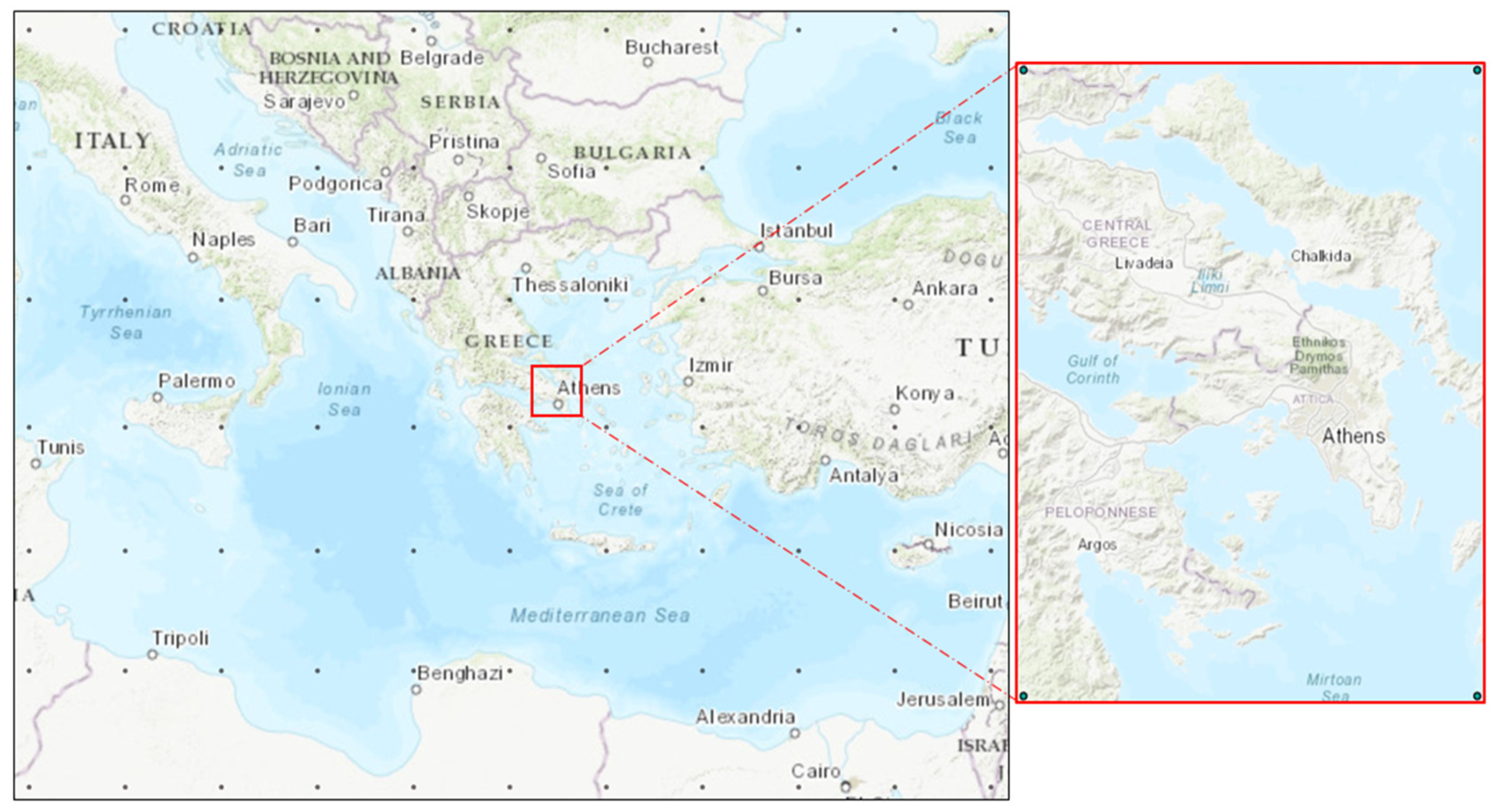
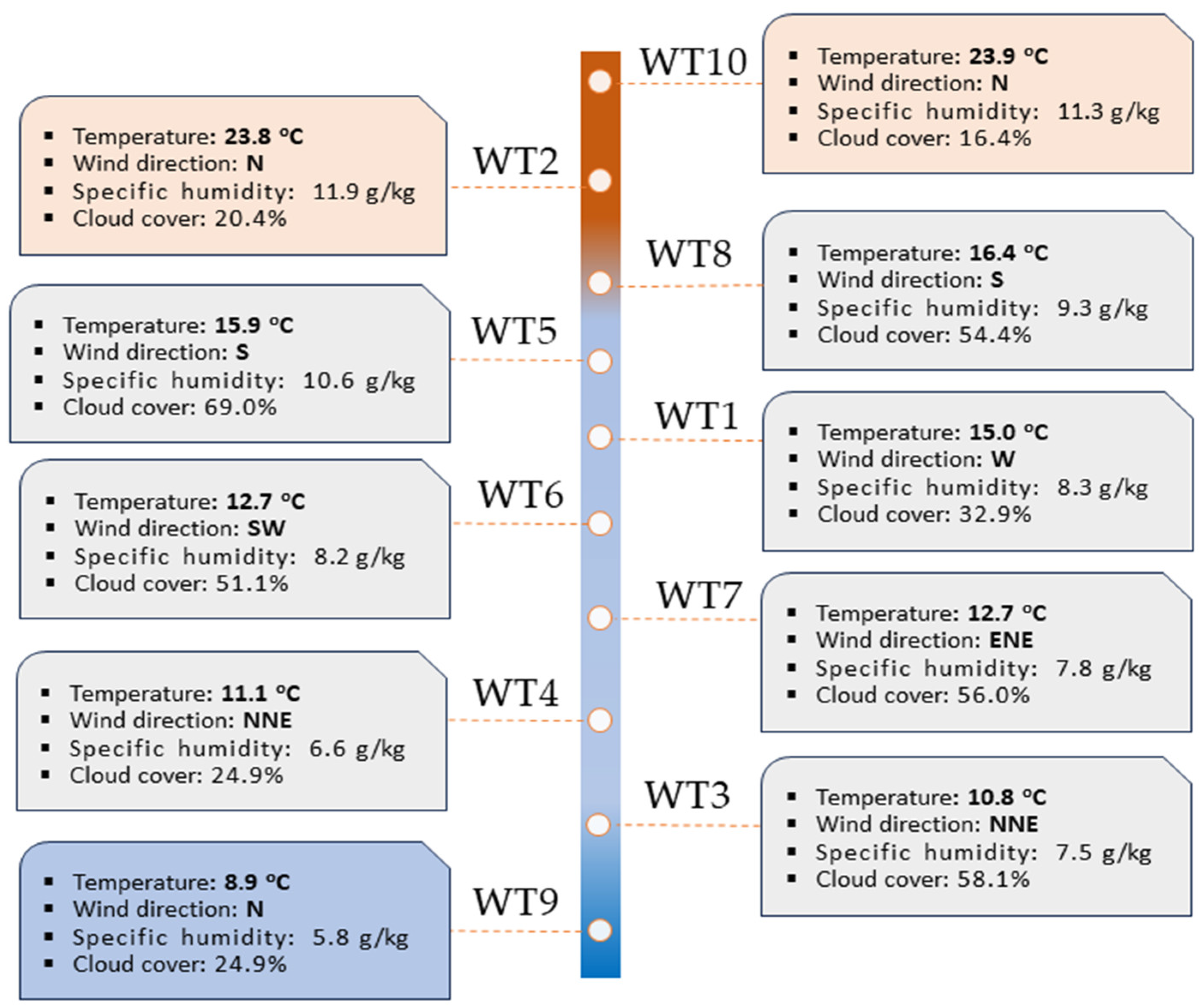
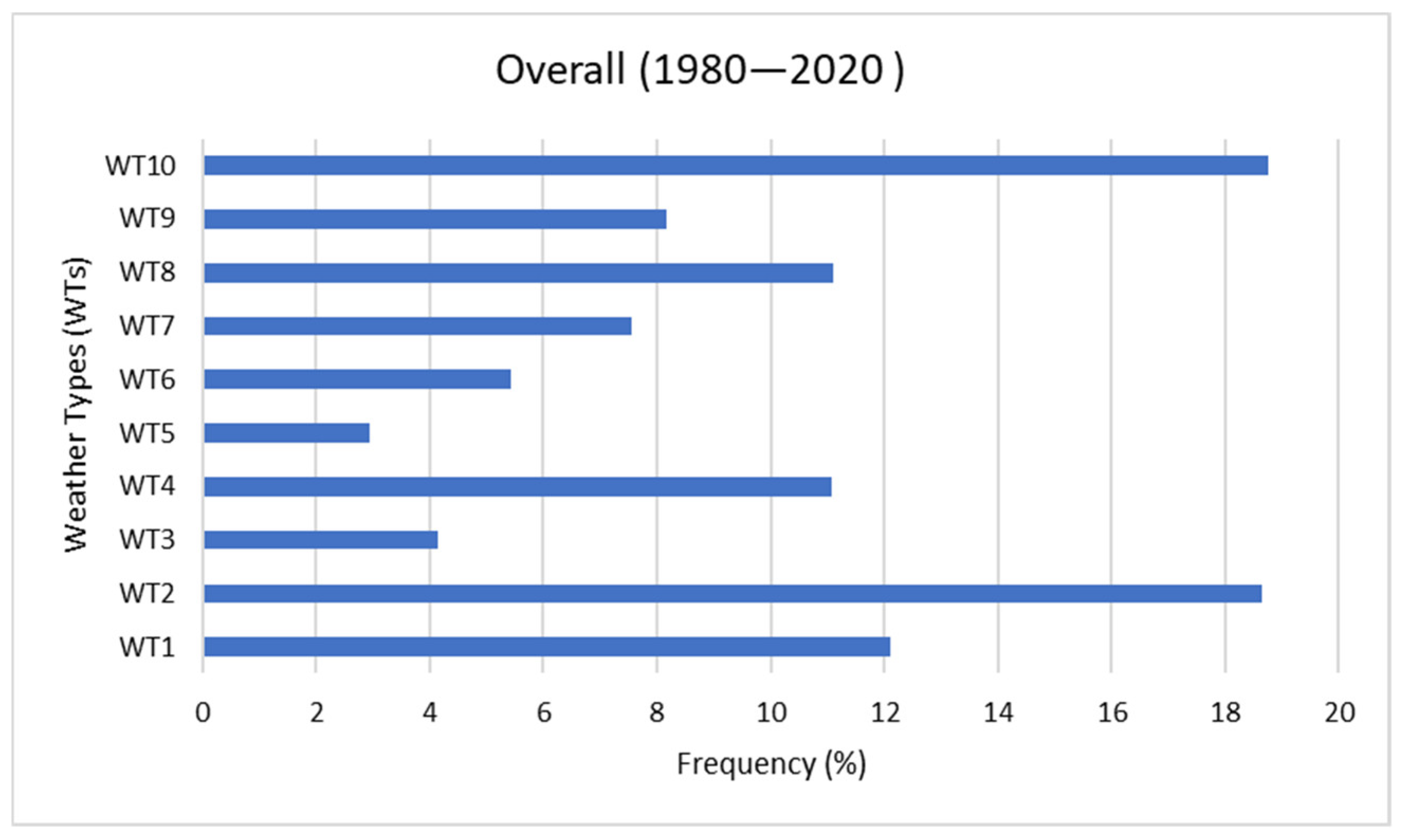
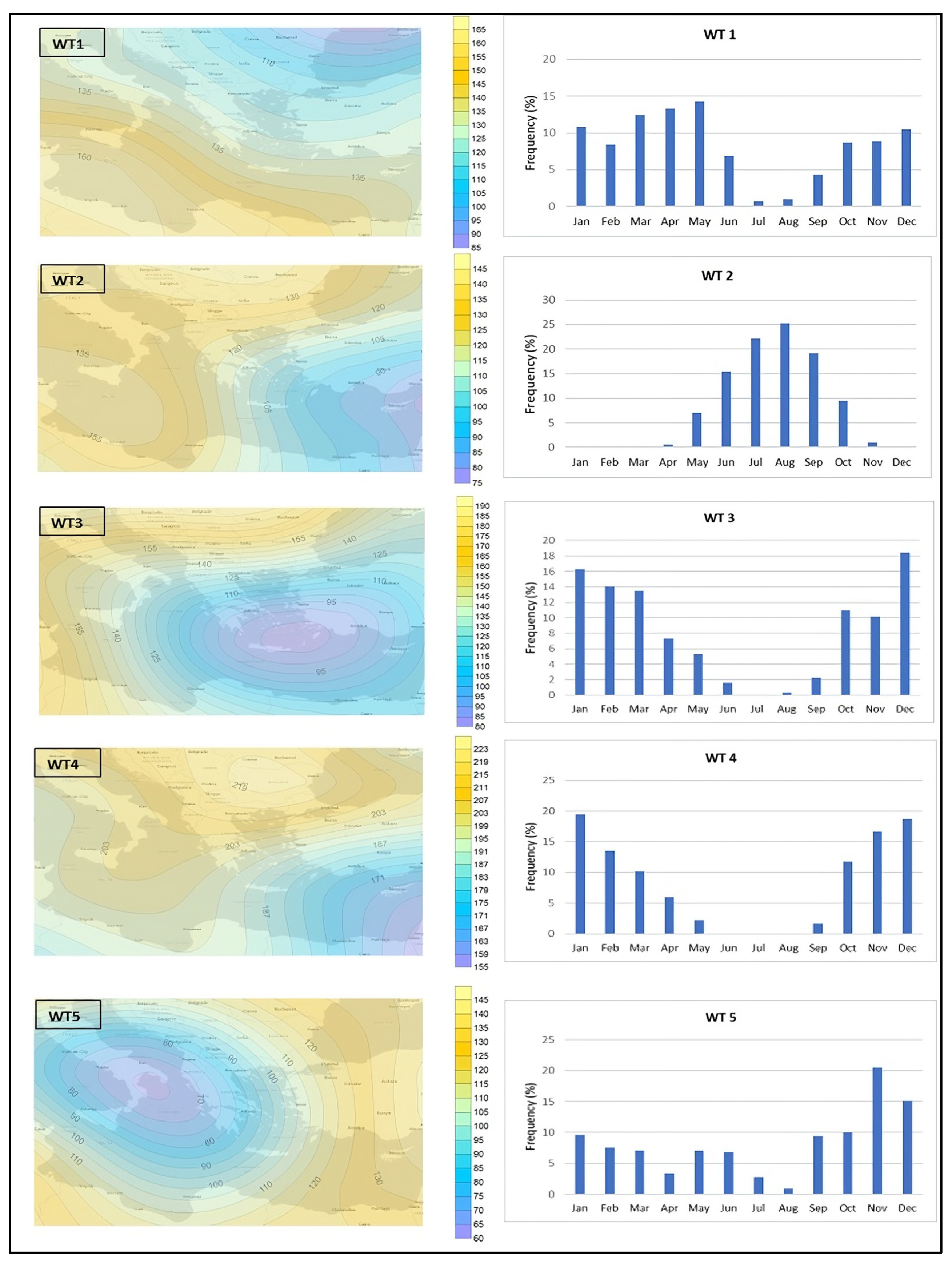
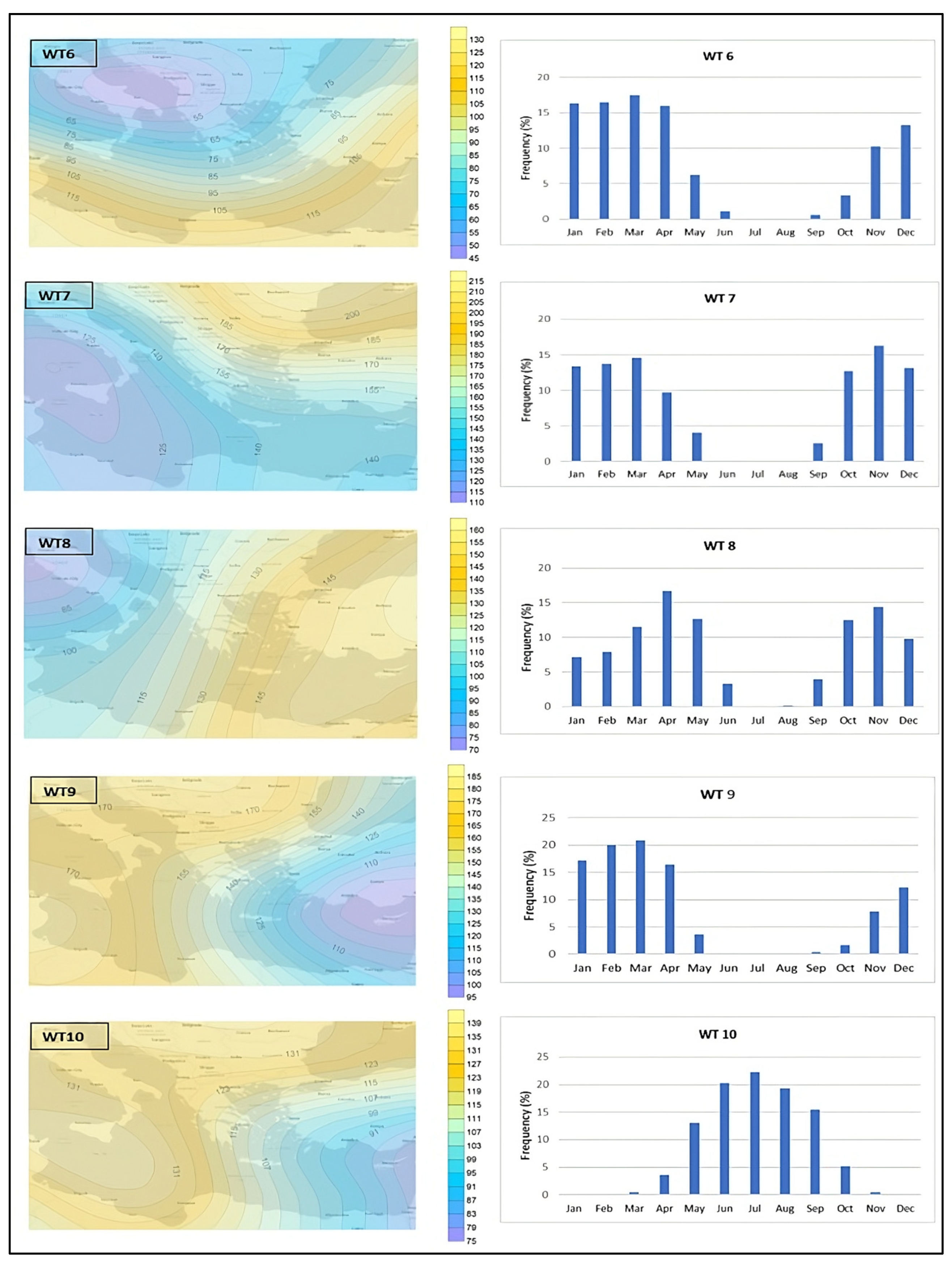
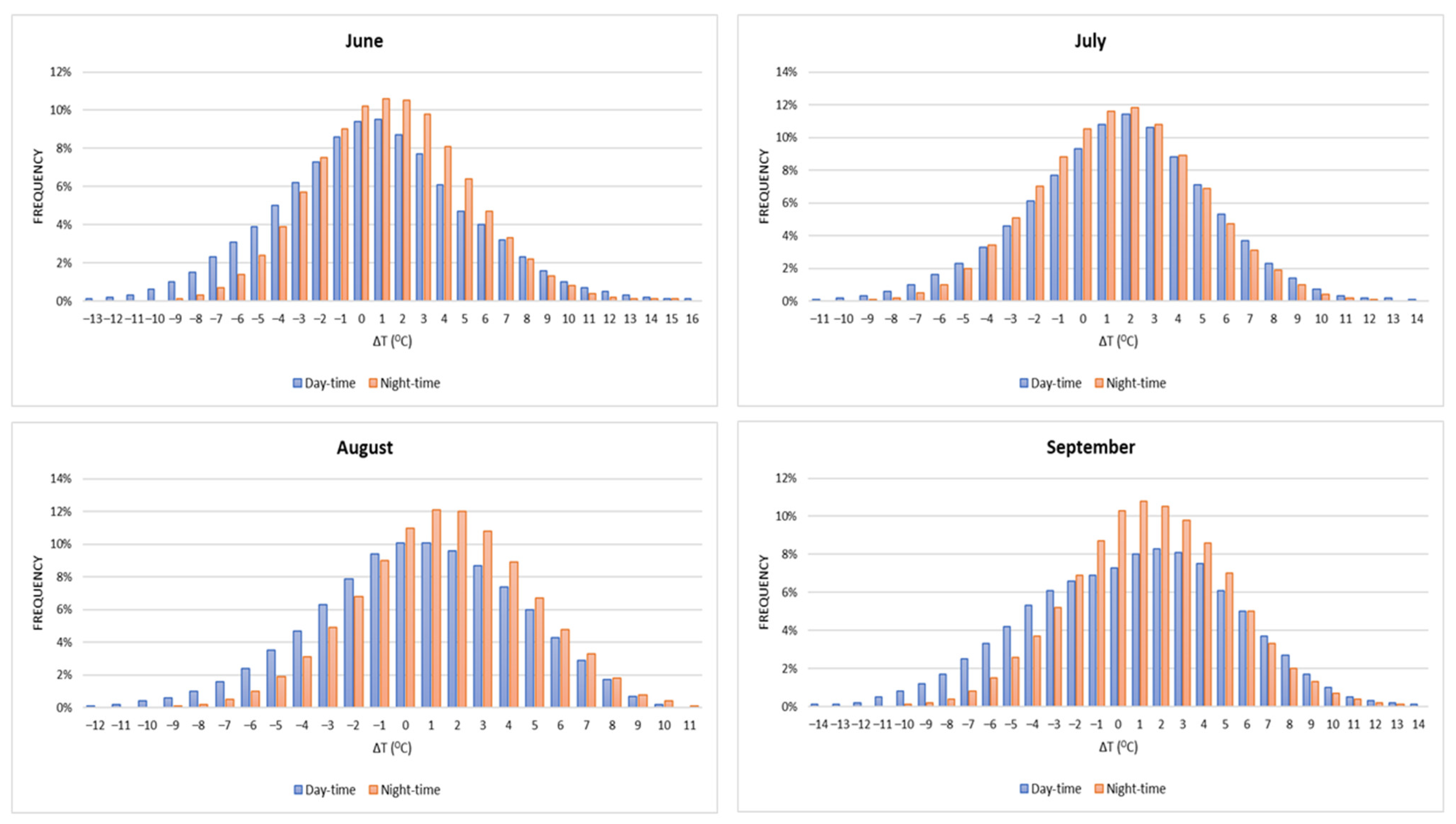
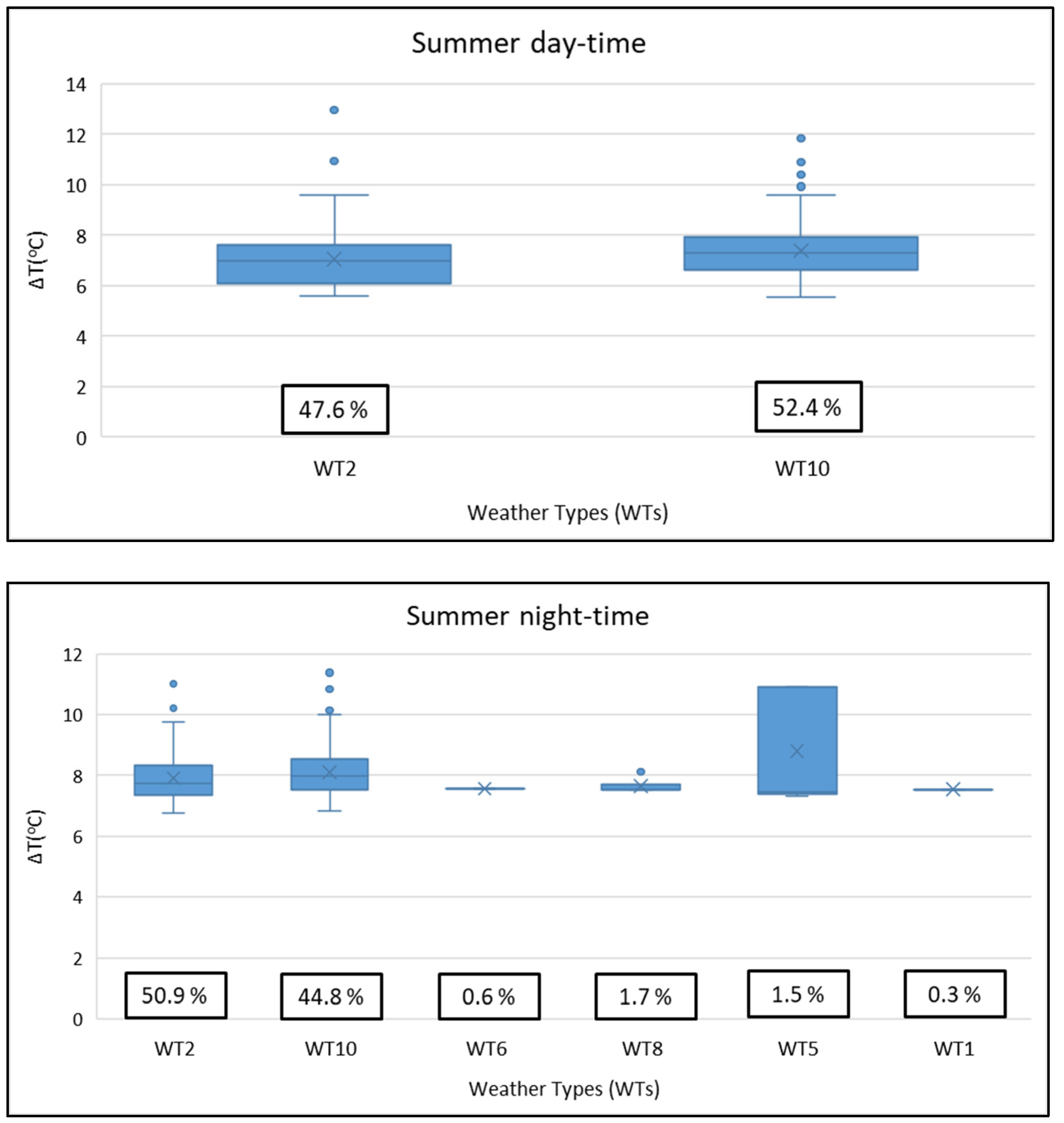

Disclaimer/Publisher’s Note: The statements, opinions and data contained in all publications are solely those of the individual author(s) and contributor(s) and not of MDPI and/or the editor(s). MDPI and/or the editor(s) disclaim responsibility for any injury to people or property resulting from any ideas, methods, instructions or products referred to in the content. |
© 2023 by the authors. Licensee MDPI, Basel, Switzerland. This article is an open access article distributed under the terms and conditions of the Creative Commons Attribution (CC BY) license (https://creativecommons.org/licenses/by/4.0/).
Share and Cite
Petrou, I.; Kyriazis, N.; Kassomenos, P. Evaluating the Spatial and Temporal Characteristics of Summer Urban Overheating through Weather Types in the Attica Region, Greece. Sustainability 2023, 15, 10633. https://doi.org/10.3390/su151310633
Petrou I, Kyriazis N, Kassomenos P. Evaluating the Spatial and Temporal Characteristics of Summer Urban Overheating through Weather Types in the Attica Region, Greece. Sustainability. 2023; 15(13):10633. https://doi.org/10.3390/su151310633
Chicago/Turabian StylePetrou, Ilias, Nikolaos Kyriazis, and Pavlos Kassomenos. 2023. "Evaluating the Spatial and Temporal Characteristics of Summer Urban Overheating through Weather Types in the Attica Region, Greece" Sustainability 15, no. 13: 10633. https://doi.org/10.3390/su151310633
APA StylePetrou, I., Kyriazis, N., & Kassomenos, P. (2023). Evaluating the Spatial and Temporal Characteristics of Summer Urban Overheating through Weather Types in the Attica Region, Greece. Sustainability, 15(13), 10633. https://doi.org/10.3390/su151310633




